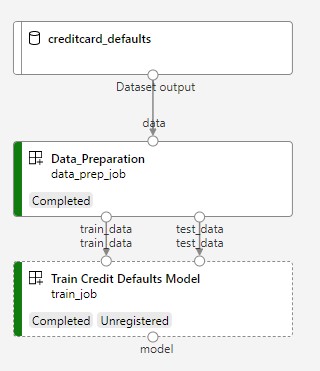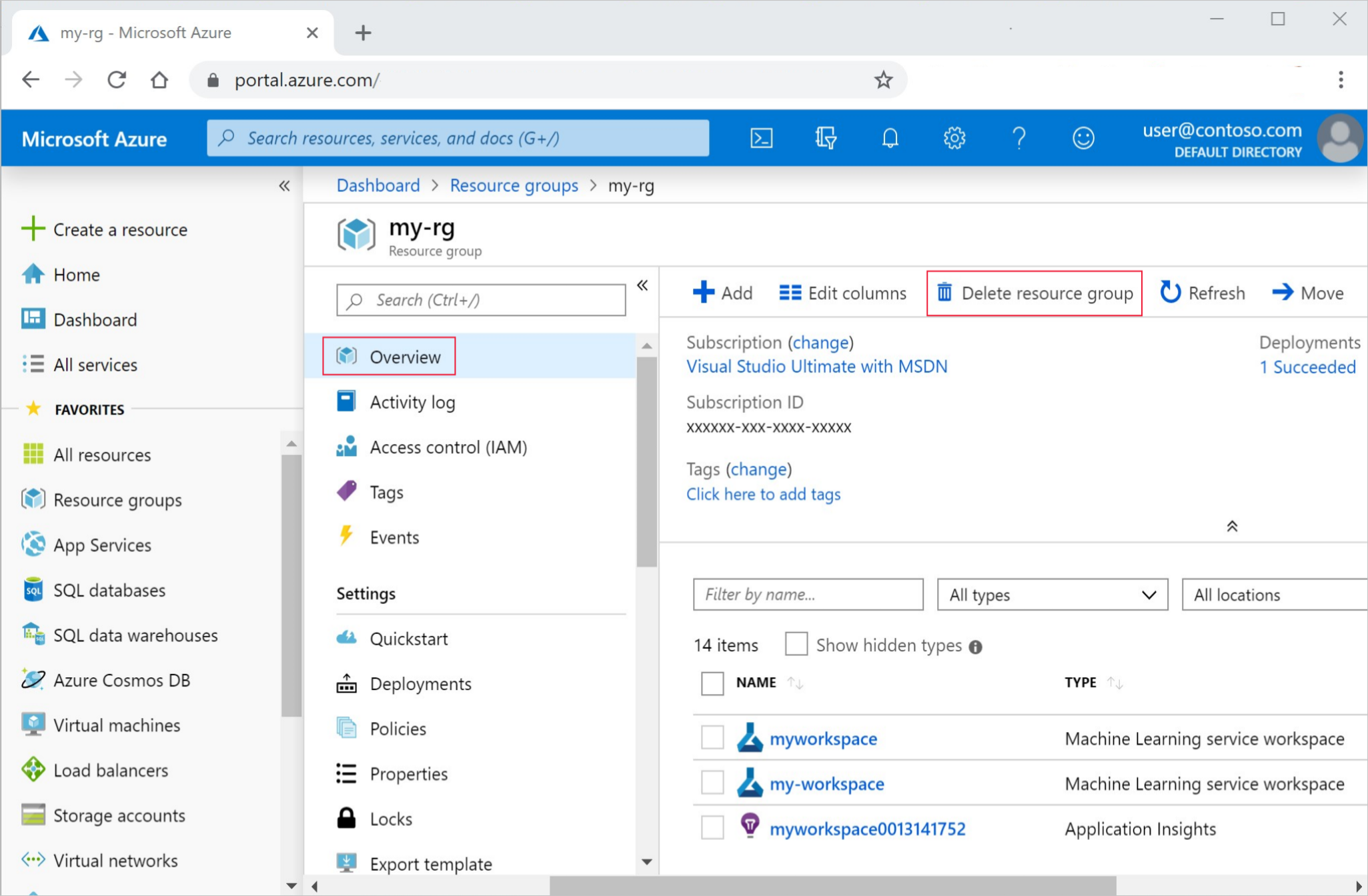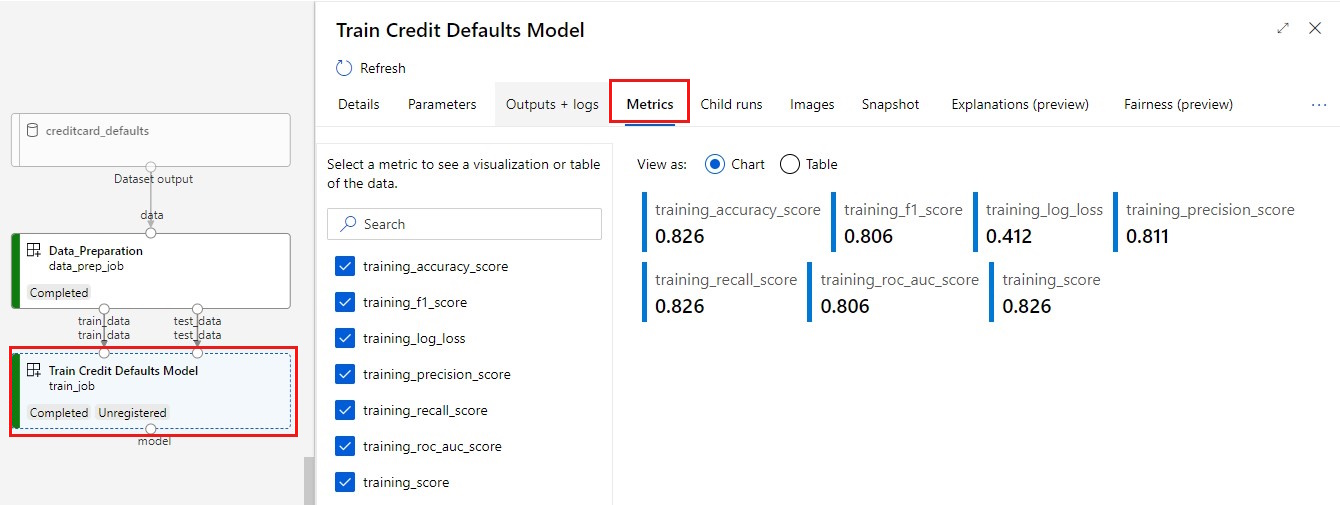適用対象:  Python SDK azure-ai-ml v2 (現行)
Python SDK azure-ai-ml v2 (現行)
注
SDK v1 を使ってパイプラインを構築するチュートリアルについては、「チュートリアル: 画像分類用の Azure Machine Learning パイプラインを構築する」を参照してください。
機械学習パイプラインの中核となるのは、完全な機械学習タスクを複数のステップから成るワークフローに分割することです。 各ステップは管理可能なコンポーネントであり、個別に開発、最適化、構成、自動化できます。 ステップは、適切に定義されたインターフェイスを使用して接続されます。 Azure Machine Learning パイプライン サービスにより、パイプラインのステップ間のすべての依存関係が自動的に調整されます。 パイプラインを使用する利点は、MLOps プラクティス、スケーラブルなチームコラボレーション、トレーニング効率、コスト削減を標準化されています。 パイプラインの利点の詳細については、「Azure Machine Learning パイプラインとは」をご覧ください。
このチュートリアルでは、Azure Machine Learning を使用して、Azure Machine Learning Python SDK v2 を使用して、運用対応の機械学習プロジェクトを作成します。 つまり、Azure Machine Learning Python SDK を使用して次のことが可能になります。
- Azure Machine Learning ワークスペースへのハンドルを取得する
- Azure Machine Learning データ資産を作成する
- 再利用可能な Azure Machine Learning コンポーネントを作成する
- Azure Machine Learning パイプラインを作成、検証、実行する
このチュートリアルでは、クレジットの不履行予測に関するモデルをトレーニングする Azure Machine Learning パイプラインを作成します。 このパイプラインには、次の 2 つのステップがあります。
- データ準備
- モデルのトレーニングとトレーニング済みモデルの登録
次の図に、送信後に Azure スタジオに表示される簡単なパイプラインを示します。
2 つの手順は、最初のデータ準備と 2 つ目のトレーニングです。

この動画では、Azure Machine Learning スタジオでチュートリアルの手順を実行できるように準備する方法について説明します。 この動画では、ノートブックの作成、コンピューティング インスタンスの作成、ノートブックの複製を行う方法について説明します。 それらの手順については、以下のセクションでも説明します。
前提条件
-
Azure Machine Learning を使用するには、ワークスペースが必要です。 まだない場合は、作業を開始するために必要なリソースの作成を完了し、ワークスペースを作成してその使用方法の詳細を確認してください。
重要
Azure Machine Learning ワークスペースがマネージド仮想ネットワークを使用して構成されている場合、パブリック Python パッケージ リポジトリへのアクセスを許可するアウトバウンド規則の追加が必要になることがあります。 詳細については、「シナリオ: パブリック機械学習パッケージにアクセスする」を参照してください。
-
スタジオにサインインして、ワークスペースを選択します (まだ開いていない場合)。
チュートリアル「データのアップロード、アクセス、探索」を完了して、このチュートリアルで必要なデータ資産を作成します。 必ずすべてのコードを実行して初期データ資産を作成してください。 必要に応じてデータを調べて修正しますが、このチュートリアルでは最初のデータのみが必要です。
-
ワークスペースでノートブックを開くか作成します。
- コードをコピーしてセルに貼り付ける場合は、新しいノートブックを作成します。
- または、スタジオの [サンプル] セクションから tutorials/get-started-notebooks/pipeline.ipynb を開きます。 次に、[複製] を選択してノートブックを [ファイル] に追加します。 サンプル ノートブックを見つけるには、「サンプル ノートブックから学習する」を参照してください。
カーネルを設定して Visual Studio Code (VS Code) で開く
コンピューティング インスタンスがまだない場合は、開いているノートブックの最上部のバーで作成します。
コンピューティング インスタンスが停止している場合は、[コンピューティングの開始] を選択して、実行されるまで待ちます。
コンピューティング インスタンスが実行中になるまで待ちます。 次に、右上にあるカーネルが
Python 3.10 - SDK v2であることを確認します。 そうでない場合は、ドロップダウン リストを使用してこのカーネルを選択します。このカーネルが表示されない場合は、コンピューティング インスタンスが実行中であることを確認します。 そうである場合は、ノートブックの右上にある [更新] ボタンを選択します。
認証が必要であることを示すバナーが表示された場合は、[認証] を選択します。
ここでノートブックを実行するか、それを VS Code で開いて、Azure Machine Learning リソースの機能を備えた完全な統合開発環境 (IDE) を使用することができます。 [VS Code で開く] を選択し、Web またはデスクトップのオプションを選択します。 この方法で起動すると、コンピューティング インスタンス、カーネル、ワークスペース ファイル システムに VS Code がアタッチされます。
重要
このチュートリアルの残りの部分には、チュートリアル ノートブックのセルが含まれています。 それらをコピーして新しいノートブックに貼り付けるか、複製した場合はここでそのノートブックに切り替えます。
パイプライン リソースを設定する
Azure Machine Learning フレームワークは、CLI、Python SDK、またはスタジオ インターフェイスから使用できます。 この例では、Azure Machine Learning Python SDK v2 を使ってパイプラインを作成します。
パイプラインを作成する前に、次のリソースが必要です。
- トレーニング用のデータ資産
- パイプラインを実行するソフトウェア環境
- ジョブの実行先となるコンピューティング リソース
ワークスペースへのハンドルを作成する
コードについて詳しく説明する前に、ワークスペースを参照する方法が必要です。 ワークスペースへのハンドルの ml_client を作成します。 その後、 ml_client を使用してリソースとジョブを管理します。
次のセルに、サブスクリプション ID、リソース グループ名、ワークスペース名を入力します。 これらの値を見つけるには:
- 右上隅の Azure Machine Learning スタジオ ツール バーで、ワークスペース名を選びます。
- ワークスペース、リソース グループ、サブスクリプション ID の値をコードにコピーします。
- 1 つの値をコピーし、領域を閉じて貼り付け、次の値に戻る必要があります。
from azure.ai.ml import MLClient
from azure.identity import DefaultAzureCredential
# authenticate
credential = DefaultAzureCredential()
SUBSCRIPTION = "<SUBSCRIPTION_ID>"
RESOURCE_GROUP = "<RESOURCE_GROUP>"
WS_NAME = "<AML_WORKSPACE_NAME>"
# Get a handle to the workspace
ml_client = MLClient(
credential=credential,
subscription_id=SUBSCRIPTION,
resource_group_name=RESOURCE_GROUP,
workspace_name=WS_NAME,
)
SDK リファレンス:
注
MLClient を作成しても、ワークスペースに接続されません。 クライアントの初期化は遅延型なので、初めて呼び出す必要が生じるまで待機します (これは、次のコード セルで行われます)。
ml_client の呼び出しを行って接続を確認します。 ワークスペースを初めて呼び出すので、認証を求められる場合があります。
# Verify that the handle works correctly.
# If you get an error here, modify your SUBSCRIPTION, RESOURCE_GROUP, and WS_NAME in the previous cell.
ws = ml_client.workspaces.get(WS_NAME)
print(ws.location, ":", ws.resource_group)
SDK リファレンス:
登録済みデータ資産にアクセスする
まずは、「チュートリアル: Azure Machine Learning でデータをアップロードし、データにアクセスし、データを探索する」で登録したデータを取得します。
- Azure Machine Learning では、データの再利用可能な定義を登録し、パイプライン内でデータを使うために
Dataオブジェクトを使います。
# get a handle of the data asset and print the URI
credit_data = ml_client.data.get(name="credit-card", version="initial")
print(f"Data asset URI: {credit_data.path}")
SDK リファレンス:
パイプライン ステップに対応するジョブ環境を作成する
これまでに、開発マシンであるコンピューティング インスタンス上に開発環境を作成しました。 パイプラインの各ステップで使う環境も必要になります。 各ステップには独自の環境を設定することや、複数のステップに共通の環境を使うことができます。
この例では、conda yaml ファイルを使って、ジョブ用の conda 環境を作成します。 まず、ファイルを格納するディレクトリを作成します。
import os
dependencies_dir = "./dependencies"
os.makedirs(dependencies_dir, exist_ok=True)
次に、依存関係ディレクトリにファイルを作成します。
%%writefile {dependencies_dir}/conda.yaml
name: model-env
channels:
- conda-forge
dependencies:
- python=3.8
- numpy=1.21.2
- pip=21.2.4
- scikit-learn=0.24.2
- scipy=1.7.1
- pandas>=1.1,<1.2
- pip:
- inference-schema[numpy-support]==1.3.0
- xlrd==2.0.1
- mlflow== 2.4.1
- azureml-mlflow==1.51.0
この仕様には、パイプラインで使う一般的なパッケージ (numpy、pip) と、Azure Machine Learning 固有のパッケージ (azureml-mlflow) が含まれています。
Azure Machine Learning パッケージは、Azure Machine Learning ジョブを実行するために必須ではありません。 ただし、これらのパッケージを追加すると、Azure Machine Learning と対話して、メトリックのログ記録とモデルの登録を行うことができます。これらはすべて Azure Machine Learning ジョブ内にあります。 これらをこのチュートリアルの後半のトレーニング スクリプトで使います。
yaml ファイルを使ってこのカスタム環境を作成し、ワークスペースに登録します。
from azure.ai.ml.entities import Environment
custom_env_name = "aml-scikit-learn"
pipeline_job_env = Environment(
name=custom_env_name,
description="Custom environment for Credit Card Defaults pipeline",
tags={"scikit-learn": "0.24.2"},
conda_file=os.path.join(dependencies_dir, "conda.yaml"),
image="mcr.microsoft.com/azureml/openmpi4.1.0-ubuntu20.04:latest",
version="0.2.0",
)
pipeline_job_env = ml_client.environments.create_or_update(pipeline_job_env)
print(
f"Environment with name {pipeline_job_env.name} is registered to workspace, the environment version is {pipeline_job_env.version}"
)
SDK リファレンス:
トレーニング パイプラインを構築する
パイプラインの実行に必要なすべての資産が揃ったので、次はパイプライン自体を構築します。
Azure Machine Learning パイプラインは、通常は複数のコンポーネントで構成される再利用可能な ML ワークフローです。 コンポーネントの一般的なライフサイクルは次のとおりです。
- コンポーネントの yaml 仕様を書くか、
ComponentMethodを使ってプログラムで作成します。 - 必要に応じて、名前とバージョンを含めてコンポーネントをワークスペースに登録し、再利用と共有ができるようにします。
- パイプライン コードからそのコンポーネントを読み込みます。
- コンポーネントの入力、出力、およびパラメーターを使用してパイプラインを実装します。
- パイプラインを送信します。
コンポーネントは、プログラム定義と yaml 定義の 2 つの方法で作成できます。 次の 2 つのセクションでは、両方の方法でコンポーネントを作成する方法について説明します。 両方のオプションを試して 2 つのコンポーネントを作成することも、好みの方法を選択することもできます。
注
このチュートリアルでは、わかりやすくするために、すべてのコンポーネントに同じコンピューティングを使用しています。 ただし、train_step.compute = "cpu-cluster" のような行を追加することで、コンポーネントごとに異なるコンピューティングを設定できます。 コンポーネントごとに異なるコンピューティングを使用してパイプラインを構築する例については、cifar-10 パイプライン チュートリアルの「Basic pipeline job (基本的なパイプライン ジョブ)」セクションを参照してください。
コンポーネント 1 の作成: データの準備 (プログラムによる定義の使用)
最初のコンポーネントを作成することから始めます。 このコンポーネントはデータの前処理を担当します。 前処理タスクは、data_prep.py Python ファイルで実行されます。
まず data_prep コンポーネントのソース フォルダーを作成します。
import os
data_prep_src_dir = "./components/data_prep"
os.makedirs(data_prep_src_dir, exist_ok=True)
このスクリプトを使って、データをトレーニングとテストのデータセットに分割するというシンプルなタスクを実行します。 Azure Machine Learning はデータセットをフォルダーとしてコンピューティングにマウントするので、マウントされた入力フォルダー内のデータ ファイルにアクセスする補助 select_first_file 関数を作成しました。
MLFlow を使用して、パイプラインの実行中にパラメーターとメトリックをログに記録します。
%%writefile {data_prep_src_dir}/data_prep.py
import os
import argparse
import pandas as pd
from sklearn.model_selection import train_test_split
import logging
import mlflow
def main():
"""Main function of the script."""
# input and output arguments
parser = argparse.ArgumentParser()
parser.add_argument("--data", type=str, help="path to input data")
parser.add_argument("--test_train_ratio", type=float, required=False, default=0.25)
parser.add_argument("--train_data", type=str, help="path to train data")
parser.add_argument("--test_data", type=str, help="path to test data")
args = parser.parse_args()
# Start Logging
mlflow.start_run()
print(" ".join(f"{k}={v}" for k, v in vars(args).items()))
print("input data:", args.data)
credit_df = pd.read_csv(args.data, header=1, index_col=0)
mlflow.log_metric("num_samples", credit_df.shape[0])
mlflow.log_metric("num_features", credit_df.shape[1] - 1)
credit_train_df, credit_test_df = train_test_split(
credit_df,
test_size=args.test_train_ratio,
)
# output paths are mounted as folder, therefore, we are adding a filename to the path
credit_train_df.to_csv(os.path.join(args.train_data, "data.csv"), index=False)
credit_test_df.to_csv(os.path.join(args.test_data, "data.csv"), index=False)
# Stop Logging
mlflow.end_run()
if __name__ == "__main__":
main()
目的のタスクを実行できるスクリプトができたので、そこから Azure Machine Learning コンポーネントを作成します。
コマンドライン アクションを実行できる汎用の CommandComponent を使います。 このコマンドライン アクションを使って、直接システム コマンドを呼び出すことや、スクリプトを実行することができます。 入出力は、コマンドラインで ${{ ... }} 表記を使って指定します。
from azure.ai.ml import command
from azure.ai.ml import Input, Output
data_prep_component = command(
name="data_prep_credit_defaults",
display_name="Data preparation for training",
description="reads a .xl input, split the input to train and test",
inputs={
"data": Input(type="uri_folder"),
"test_train_ratio": Input(type="number"),
},
outputs=dict(
train_data=Output(type="uri_folder", mode="rw_mount"),
test_data=Output(type="uri_folder", mode="rw_mount"),
),
# The source folder of the component
code=data_prep_src_dir,
command="""python data_prep.py \
--data ${{inputs.data}} --test_train_ratio ${{inputs.test_train_ratio}} \
--train_data ${{outputs.train_data}} --test_data ${{outputs.test_data}} \
""",
environment=f"{pipeline_job_env.name}:{pipeline_job_env.version}",
)
SDK リファレンス:
必要に応じて、将来再利用できるようにコンポーネントをワークスペースに登録します。
# Now register the component to the workspace
data_prep_component = ml_client.create_or_update(data_prep_component.component)
# Create and register the component in your workspace
print(
f"Component {data_prep_component.name} with Version {data_prep_component.version} is registered"
)
SDK リファレンス:
コンポーネント 2 の作成: トレーニング (yaml 定義の使用)
作成する 2 つ目のコンポーネントは、トレーニングとテストのデータを使用し、ツリー ベース モデルをトレーニングして出力モデルを返します。 Azure Machine Learning のログ機能を使って学習の進行状況を記録し、視覚化します。
最初のコンポーネントを作成するときには CommandComponent クラスを使いました。 今回は、yaml 定義を使って 2 つ目のコンポーネントを定義します。 それぞれ方法に独自の利点があります。 yaml 定義は、コードに沿って実際にチェックインでき、読み取り可能な履歴追跡を提供します。
CommandComponent を使ったプログラムによる方法は、組み込みのクラス ドキュメントとコード補完を使って、より簡単に行うことができます。
このコンポーネント用のディレクトリを作成します。
import os
train_src_dir = "./components/train"
os.makedirs(train_src_dir, exist_ok=True)
このディレクトリ内にトレーニング スクリプトを作成します。
%%writefile {train_src_dir}/train.py
import argparse
from sklearn.ensemble import GradientBoostingClassifier
from sklearn.metrics import classification_report
import os
import pandas as pd
import mlflow
def select_first_file(path):
"""Selects first file in folder, use under assumption there is only one file in folder
Args:
path (str): path to directory or file to choose
Returns:
str: full path of selected file
"""
files = os.listdir(path)
return os.path.join(path, files[0])
# Start Logging
mlflow.start_run()
# enable autologging
mlflow.sklearn.autolog()
os.makedirs("./outputs", exist_ok=True)
def main():
"""Main function of the script."""
# input and output arguments
parser = argparse.ArgumentParser()
parser.add_argument("--train_data", type=str, help="path to train data")
parser.add_argument("--test_data", type=str, help="path to test data")
parser.add_argument("--n_estimators", required=False, default=100, type=int)
parser.add_argument("--learning_rate", required=False, default=0.1, type=float)
parser.add_argument("--registered_model_name", type=str, help="model name")
parser.add_argument("--model", type=str, help="path to model file")
args = parser.parse_args()
# paths are mounted as folder, therefore, we are selecting the file from folder
train_df = pd.read_csv(select_first_file(args.train_data))
# Extracting the label column
y_train = train_df.pop("default payment next month")
# convert the dataframe values to array
X_train = train_df.values
# paths are mounted as folder, therefore, we are selecting the file from folder
test_df = pd.read_csv(select_first_file(args.test_data))
# Extracting the label column
y_test = test_df.pop("default payment next month")
# convert the dataframe values to array
X_test = test_df.values
print(f"Training with data of shape {X_train.shape}")
clf = GradientBoostingClassifier(
n_estimators=args.n_estimators, learning_rate=args.learning_rate
)
clf.fit(X_train, y_train)
y_pred = clf.predict(X_test)
print(classification_report(y_test, y_pred))
# Registering the model to the workspace
print("Registering the model via MLFlow")
mlflow.sklearn.log_model(
sk_model=clf,
registered_model_name=args.registered_model_name,
artifact_path=args.registered_model_name,
)
# Saving the model to a file
mlflow.sklearn.save_model(
sk_model=clf,
path=os.path.join(args.model, "trained_model"),
)
# Stop Logging
mlflow.end_run()
if __name__ == "__main__":
main()
このトレーニング スクリプトでわかるように、モデルのトレーニングが完了すると、モデル ファイルが保存され、ワークスペースに登録されます。 これで、登録したモデルを推論エンドポイントで使用できるようになりました。
このステップの環境には、組み込みの (キュレーションされた) Azure Machine Learning 環境のいずれかを使います。
azureml というタグは、キュレーションされた環境内でその名前の検索を使うようにシステムに指示するものです。
まずコンポーネントを記述する yaml ファイルを作成します。
%%writefile {train_src_dir}/train.yml
# <component>
name: train_credit_defaults_model
display_name: Train Credit Defaults Model
# version: 1 # Not specifying a version will automatically update the version
type: command
inputs:
train_data:
type: uri_folder
test_data:
type: uri_folder
learning_rate:
type: number
registered_model_name:
type: string
outputs:
model:
type: uri_folder
code: .
environment:
# for this step, we'll use an AzureML curate environment
azureml://registries/azureml/environments/sklearn-1.0/labels/latest
command: >-
python train.py
--train_data ${{inputs.train_data}}
--test_data ${{inputs.test_data}}
--learning_rate ${{inputs.learning_rate}}
--registered_model_name ${{inputs.registered_model_name}}
--model ${{outputs.model}}
# </component>
次に、コンポーネントを作成して登録します。 登録すると、他のパイプラインで再利用できます。 また、ワークスペースにアクセスできる他のユーザーが、登録済みコンポーネントを使用できます。
# importing the Component Package
from azure.ai.ml import load_component
# Loading the component from the yml file
train_component = load_component(source=os.path.join(train_src_dir, "train.yml"))
# Now register the component to the workspace
train_component = ml_client.create_or_update(train_component)
# Create and register the component in your workspace
print(
f"Component {train_component.name} with Version {train_component.version} is registered"
)
SDK リファレンス:
コンポーネントからパイプラインを作成する
コンポーネントの定義と登録が完了したので、パイプラインの実装を開始できます。
ここでは、 入力データ、 分割率、および 登録済みモデル名 を入力変数として使用します。 次にコンポーネントを呼び出し、入出力の識別子を使ってそれらを接続します。 各ステップの出力には、.outputs プロパティを使ってアクセスできます。
load_component()によって返される Python 関数は、パイプライン内で各ステップを呼び出すために使用する通常の Python 関数として機能します。
パイプラインをコーディングするには、Azure Machine Learning パイプラインを識別する特定の @dsl.pipeline デコレーターを使います。 デコレーターでは、パイプラインの説明と、コンピューティングやストレージなどの既定のリソースを指定できます。 Python 関数と同様に、パイプラインには入力を含めることができます。 次に、異なる入力を持つ 1 つのパイプラインの複数のインスタンスを作成できます。
ここでは、 入力データ、 分割率、および 登録済みモデル名 を入力変数として使用します。 その後、コンポーネントを呼び出し、入力/出力識別子を使用して接続します。 各ステップの出力には、.outputs プロパティを使ってアクセスできます。
# the dsl decorator tells the sdk that we are defining an Azure Machine Learning pipeline
from azure.ai.ml import dsl, Input, Output
@dsl.pipeline(
compute="serverless", # "serverless" value runs pipeline on serverless compute
description="E2E data_perp-train pipeline",
)
def credit_defaults_pipeline(
pipeline_job_data_input,
pipeline_job_test_train_ratio,
pipeline_job_learning_rate,
pipeline_job_registered_model_name,
):
# using data_prep_function like a python call with its own inputs
data_prep_job = data_prep_component(
data=pipeline_job_data_input,
test_train_ratio=pipeline_job_test_train_ratio,
)
# using train_func like a python call with its own inputs
train_job = train_component(
train_data=data_prep_job.outputs.train_data, # note: using outputs from previous step
test_data=data_prep_job.outputs.test_data, # note: using outputs from previous step
learning_rate=pipeline_job_learning_rate, # note: using a pipeline input as parameter
registered_model_name=pipeline_job_registered_model_name,
)
# a pipeline returns a dictionary of outputs
# keys will code for the pipeline output identifier
return {
"pipeline_job_train_data": data_prep_job.outputs.train_data,
"pipeline_job_test_data": data_prep_job.outputs.test_data,
}
SDK リファレンス:
次に、パイプライン定義を使い、データセット、選んだ分割比率、モデルに選んだ名前を指定してパイプラインのインスタンスを作成します。
registered_model_name = "credit_defaults_model"
# Let's instantiate the pipeline with the parameters of our choice
pipeline = credit_defaults_pipeline(
pipeline_job_data_input=Input(type="uri_file", path=credit_data.path),
pipeline_job_test_train_ratio=0.25,
pipeline_job_learning_rate=0.05,
pipeline_job_registered_model_name=registered_model_name,
)
SDK リファレンス:
ジョブを送信する
次に、Azure Machine Learning で実行するジョブを送信します。 今回は、create_or_update で ml_client.jobs を使用します。
ここでは実験名も渡します。 実験とは、あるプロジェクトに対して実行するすべてのイテレーション用のコンテナーです。 同じ実験名で送信されたすべてのジョブは、Azure Machine Learning スタジオ上ではすべて隣り合わせに表示されます。
完了すると、パイプラインはトレーニングの結果としてワークスペースにモデルを登録します。
# submit the pipeline job
pipeline_job = ml_client.jobs.create_or_update(
pipeline,
# Project's name
experiment_name="e2e_registered_components",
)
ml_client.jobs.stream(pipeline_job.name)
SDK リファレンス:
- JobOperations.create_or_update(ジョブ操作の作成または更新)
- JobOperations.stream
前のセルに生成されたリンクを使って、パイプラインの進行状況を追跡できます。 このリンクを最初に選択すると、パイプラインがまだ実行されていることがわかります。 完了したら、各コンポーネントの結果を調べることができます。
[Train Credit Defaults Model] コンポーネントをダブルクリックします。
トレーニングについては、次の 2 つの重要な結果を確認する必要があります。
ログを表示する。
メトリックを表示する。[メトリック] タブを選択します。このセクションには、ログに記録されたさまざまなメトリックが表示されます。 この例では、mlflow
autologgingによってトレーニング メトリックが自動的にログに記録されています。
モデルをオンライン エンドポイントとしてデプロイする
オンライン エンドポイントにモデルをデプロイする方法については、「オンライン エンドポイントとしてモデルをデプロイする」のチュートリアルを参照してください。
リソースをクリーンアップする
引き続き他のチュートリアルに取り組む場合は、「次のステップ」に進んでください。
コンピューティング インスタンスを停止する
ここで使用しない場合は、コンピューティング インスタンスを停止します。
- スタジオの左側のウィンドウで、[ コンピューティング] を選択します。
- 上部のタブで、 [コンピューティング インスタンス] を選択します
- 一覧からコンピューティング インスタンスを選択します。
- 上部のツールバーで、 [停止] を選択します。
すべてのリソースの削除
重要
作成したリソースは、Azure Machine Learning に関連したその他のチュートリアルおよびハウツー記事の前提条件として使用できます。
作成したどのリソースも今後使用する予定がない場合は、課金が発生しないように削除します。
Azure portal の検索ボックスに「リソース グループ」と入力し、それを結果から選択します。
一覧から、作成したリソース グループを選択します。
[概要] ページで、[リソース グループの削除] を選択します。

リソース グループ名を入力します。 次に、 [削除] を選択します。
次のステップ
機械学習パイプライン ジョブをスケジュールする方法を学びます





